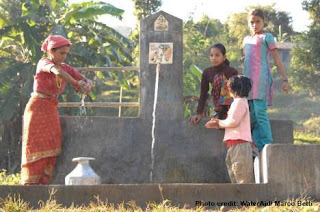 The himalayan country of Nepal most often faces problems of water stresses at various part of the country though a second most rich country of the world in terms of water resources.The region is very extensive and covers about 50% of the total area of Nepal. Its elevation ranges from 600m to 3000m. Its topography consists of Mahabharat Ranges, Churia Hills, and elevated flattish land and river valleys. There are some isolated broad valleys lying in between the Mahabharat and Churia Ranges. These are known as Duns or Inner TarNewsletter . In some villages in the hills of Nepal, drinking water is supplied to consumers through a bamboo pipin
The himalayan country of Nepal most often faces problems of water stresses at various part of the country though a second most rich country of the world in terms of water resources.The region is very extensive and covers about 50% of the total area of Nepal. Its elevation ranges from 600m to 3000m. Its topography consists of Mahabharat Ranges, Churia Hills, and elevated flattish land and river valleys. There are some isolated broad valleys lying in between the Mahabharat and Churia Ranges. These are known as Duns or Inner TarNewsletter . In some villages in the hills of Nepal, drinking water is supplied to consumers through a bamboo pipin g system. In Barbotey Village, in the Ilam District of Nepal, for example, water is supplied to two households (12 people) from a common source. A longitudinally cut bamboo tube, semi-circular in cross-section, serves as an intake. Water, drawn from the source, flow along about 100 m of open channel bamboo piping to a bamboo tap. Water flows by gravity down a 1% slope that follows the ground profile. The bamboo pipes, supports and ancillary plumbing fixtures are made from bamboo stems cut from the nearby forests.
g system. In Barbotey Village, in the Ilam District of Nepal, for example, water is supplied to two households (12 people) from a common source. A longitudinally cut bamboo tube, semi-circular in cross-section, serves as an intake. Water, drawn from the source, flow along about 100 m of open channel bamboo piping to a bamboo tap. Water flows by gravity down a 1% slope that follows the ground profile. The bamboo pipes, supports and ancillary plumbing fixtures are made from bamboo stems cut from the nearby forests.In some part of hilly region of Nepal,there are three main types of project,they are gravity flow project and spring protection.

Both gravity flow and spring protection projects are projects that are used in the hill regions of Nepal. They rely on gravity as a means to move the water from point A to point B. As a result, both systems are very similar in design. The main difference lies in the length and complexity of the scheme. Gravity flow projects cover up to 20 kilometers in length of pipeline where spring protection projects cover only about 10 meters in length. In other words, gravity flow projects aim at protecting the source and transporting the water as close as possible to the users and protecting the source. Spring protection only concerns itself with protection of the source, no transportation.
0 comments:
Post a Comment